Lesson10
- 格式:ppt
- 大小:968.50 KB
- 文档页数:2
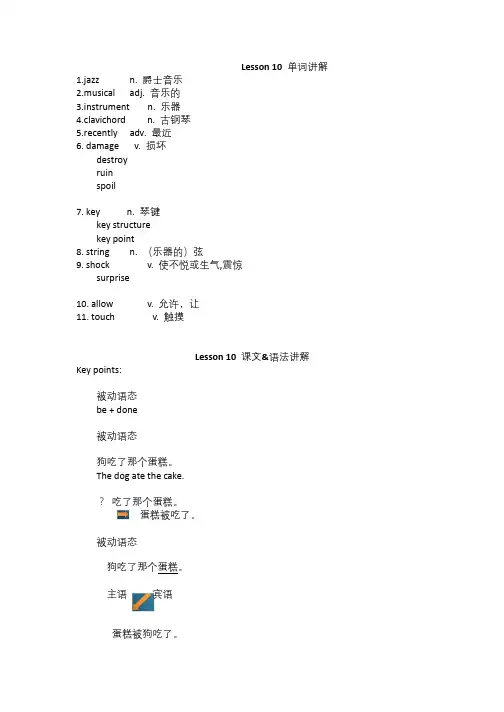
Lesson10单词讲解1.jazz n.爵士音乐2.musical adj.音乐的3.instrument n.乐器4.clavichord n.古钢琴5.recently adv.最近6.damage v.损坏destroyruinspoil7.key n.琴键key structurekey point8.string n.(乐器的)弦9.shock v.使不悦或生气,震惊surprise10.allow v.允许,让11.touch v.触摸Lesson10课文&语法讲解Key points:被动语态be+done被动语态狗吃了那个蛋糕。
The dog ate the cake.?吃了那个蛋糕。
蛋糕被吃了。
被动语态狗吃了那个蛋糕。
主语宾语蛋糕被狗吃了。
被动语态be+done教室每天都打扫。
Classrooms____________(clean)every day.被动语态be+done被动语态be+done教室每天都打扫。
Classrooms are cleaned(clean)every day.被动语态be+done一座新的大楼去年建造的。
A new building was built(build)last year.被动语态be+done他每天被打。
他昨天被打了。
他明天将要被打。
他现在正在被打。
被动语态be+done 他每天被打。
He is beaten every day.他昨天被打了。
He was beatenyesterday.他明天将要被打。
He will be beatentomorrow.他现在正在被打。
He is being beaten.English is spoken(speak)all over the world. The stadium was built(build)in1998.罗马不是一天建成的。
Rome was not built in a day.人们现在正在被广告所影响。
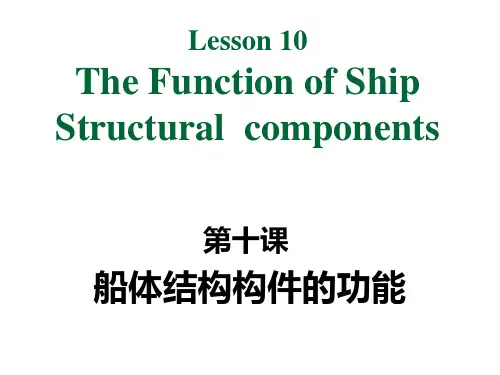

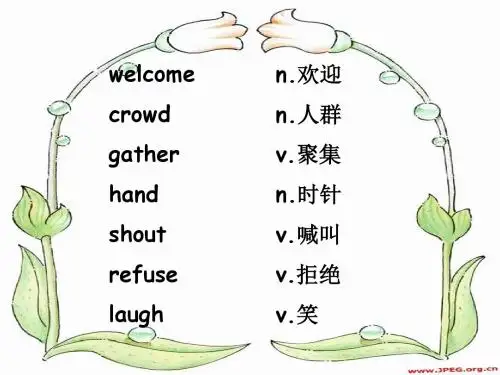
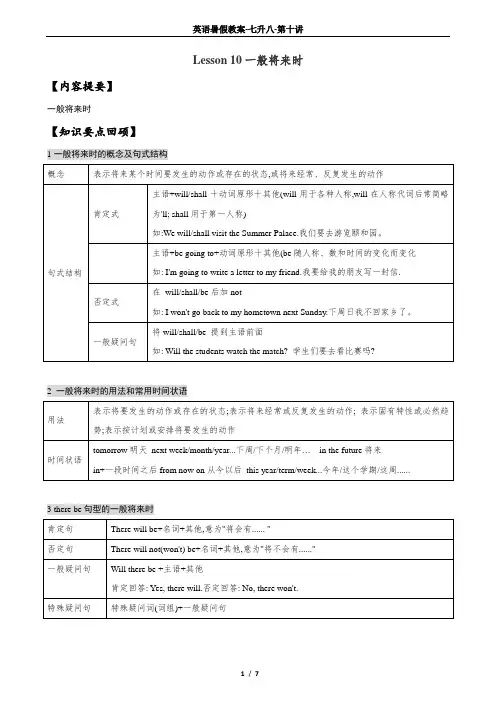
Lesson 10一般将来时【内容提要】一般将来时【知识要点回硕】1一般将来时的概念及句式结构2 一般将来时的用法和常用时间状语3 there be句型的一般将来时例1 We some robots at home in the future, and there some in the office, too.A. will have; will haveB. have; will beC. will have; will be[讲解] 本题考查there be 句型的一般将来时由in the future 可知句子要用一般将来时。
一般将来时的结构为: will+动词原形;there be句型一般将来时的肯定形式为there will be+名词+其他,所以用will have 和will be。
[答案] C例2 --- Do you have any plans for tonight?--- Yes, I at the new Italian restaurant in town.A. eatB. have eatenC. am going to eat[讲解] 本题考查一般将来时根据关键词plans for tonight今晚的计划、安排,可知要用一般将来时。
一般将来时的结构: will/be going to+动词原形,所以用am going to eat。
[答案] D【知识点拨】be going to+动词原形与will+动词原形1. will/shall+动词原形,表示单纯意义"将来要(会).... ",没有计划性,或者客观必然会发生的事。
另外,还可以用于问对方是否愿意或者表示客气的邀请或命令。
2. be going to+动词原形,表示"将要发生... " "打算/计划/决定要...... "。
例3 --- Where you in the United States?--- I'm going to visit the Statue of Liberty.A. are; visitB. will; visitC. have; visited[讲解] 本题考查一般将来时的特殊疑问句。
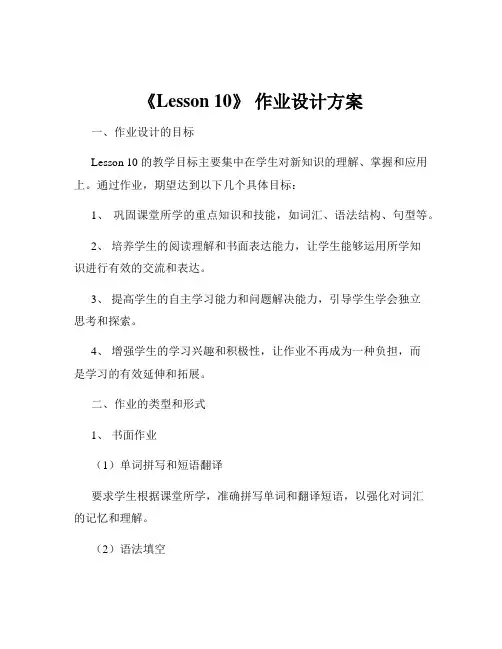
《Lesson 10》作业设计方案一、作业设计的目标Lesson 10 的教学目标主要集中在学生对新知识的理解、掌握和应用上。
通过作业,期望达到以下几个具体目标:1、巩固课堂所学的重点知识和技能,如词汇、语法结构、句型等。
2、培养学生的阅读理解和书面表达能力,让学生能够运用所学知识进行有效的交流和表达。
3、提高学生的自主学习能力和问题解决能力,引导学生学会独立思考和探索。
4、增强学生的学习兴趣和积极性,让作业不再成为一种负担,而是学习的有效延伸和拓展。
二、作业的类型和形式1、书面作业(1)单词拼写和短语翻译要求学生根据课堂所学,准确拼写单词和翻译短语,以强化对词汇的记忆和理解。
(2)语法填空设计一些包含本节课重点语法点的句子,让学生进行填空练习,加深对语法规则的掌握。
(3)句子改写给出一些原句,要求学生根据特定的要求进行改写,如将陈述句改为疑问句、主动句改为被动句等,锻炼学生对句型的灵活运用。
2、阅读作业(1)短文阅读提供一篇与本节课主题相关的短文,设置一些理解性问题,让学生在阅读后回答,培养阅读理解能力。
(2)阅读拓展推荐一篇课外的英语文章或书籍片段,让学生自主阅读,并写下简单的读后感或总结,拓展阅读视野。
3、口语作业(1)对话练习布置一些与课堂内容相关的情景,让学生两两一组进行对话练习,并录制音频提交,提高口语表达能力。
(2)口语模仿提供一段英语原声录音,让学生模仿语音、语调进行朗读,并录制提交,培养良好的发音习惯。
4、实践作业(1)英语日记要求学生用英语记录当天的生活经历或感受,运用所学知识进行表达。
(2)主题调研让学生围绕一个与本节课相关的主题,如某种文化现象或社会问题,进行简单的调研,并以英语汇报调研结果。
三、作业的难度层次作业分为基础、提高和拓展三个难度层次,以满足不同学生的学习需求。
1、基础层次主要针对学习能力较弱的学生,侧重于基础知识的巩固和简单应用,如单词拼写、简单的语法练习等。
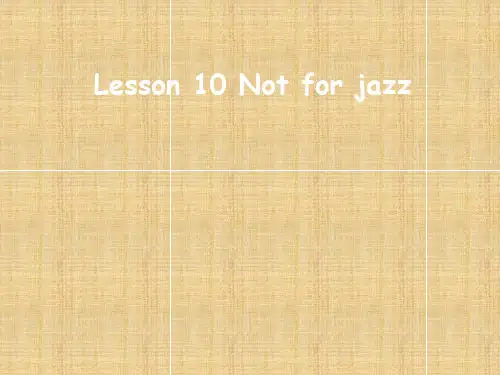

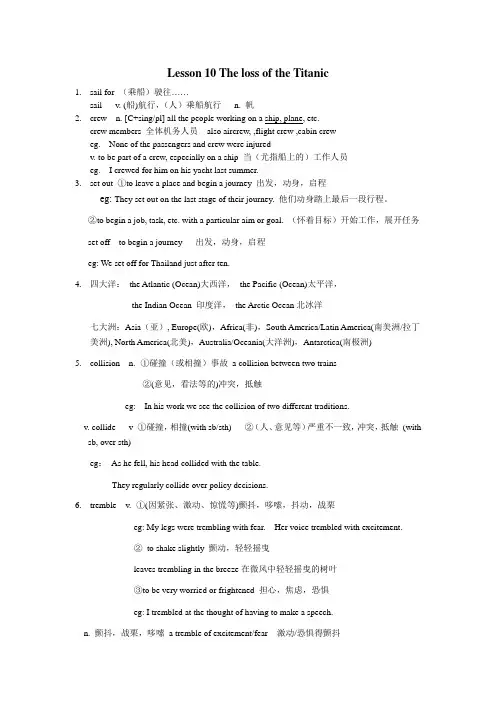
Lesson 10 The loss of the Titanic1.sail for (乘船)驶往……sail v. (船)航行,(人)乘船航行n. 帆2.crew n. [C+sing/pl] all the people working on a ship, plane, etc.crew members 全体机务人员also aircrew, ,flight crew ,cabin creweg. None of the passengers and crew were injuredv. to be part of a crew, especially on a ship 当(尤指船上的)工作人员eg. I crewed for him on his yacht last summer.3.set out ①to leave a place and begin a journey 出发,动身,启程eg: They set out on the last stage of their journey. 他们动身踏上最后一段行程。
②to begin a job, task, etc. with a particular aim or goal. (怀着目标)开始工作,展开任务set off to begin a journey 出发,动身,启程eg: We set off for Thailand just after ten.4.四大洋:the Atlantic (Ocean)大西洋,the Pacific (Ocean)太平洋,the Indian Ocean 印度洋,the Arctic Ocean北冰洋七大洲:Asia(亚), Europe(欧),Africa(非),South America/Latin America(南美洲/拉丁美洲), North America(北美),Australia/Oceania(大洋洲),Antarctica(南极洲)5.collision n.①碰撞(或相撞)事故a collision between two trains②(意见,看法等的)冲突,抵触eg: In his work we see the collision of two different traditions.v. collide v ①碰撞,相撞(with sb/sth) ②(人、意见等)严重不一致,冲突,抵触(with sb, over sth)eg:As he fell, his head collided with the table.They regularly collide over policy decisions.6.tremble v.①(因紧张、激动、惊慌等)颤抖,哆嗦,抖动,战栗eg: My legs were trembling with fear. Her voice trembled with excitement.②to shake slightly 颤动,轻轻摇曳leaves trembling in the breeze在微风中轻轻摇曳的树叶③to be very worried or frightened 担心,焦虑,恐惧eg: I trembled at the thought of having to make a speech.n. 颤抖,战栗,哆嗦a tremble of excitement/fear 激动/恐惧得颤抖7. plunge v/nv.①to move or make sth move suddenly forwards or downwards. 使突然前冲或下落eg: She lost her balance and plunged 100 feet to her death.②(of price, temperatures, etc.)to decrease suddenly and quicklyeg: Stock markets plunged at the news of the coup.n. ①突然跌落/分离②(价格、数量等)暴跌,猛降,骤减Grammar: Suffix。
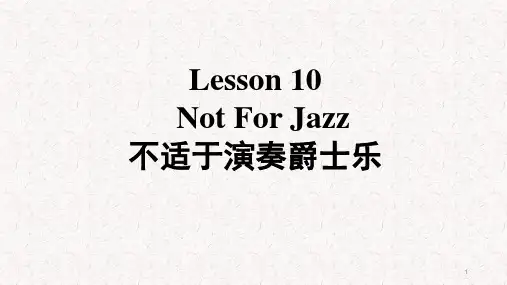
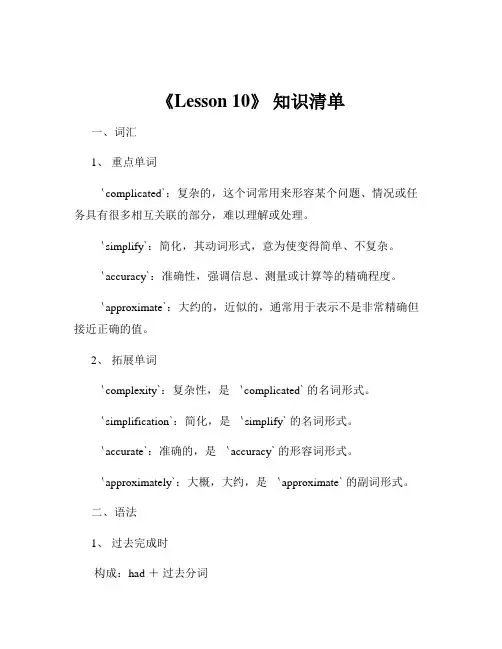
《Lesson 10》知识清单一、词汇1、重点单词`complicated`:复杂的,这个词常用来形容某个问题、情况或任务具有很多相互关联的部分,难以理解或处理。
`simplify`:简化,其动词形式,意为使变得简单、不复杂。
`accuracy`:准确性,强调信息、测量或计算等的精确程度。
`approximate`:大约的,近似的,通常用于表示不是非常精确但接近正确的值。
2、拓展单词`complexity`:复杂性,是`complicated` 的名词形式。
`simplification`:简化,是`simplify` 的名词形式。
`accurate`:准确的,是`accuracy` 的形容词形式。
`approximately`:大概,大约,是`approximate` 的副词形式。
二、语法1、过去完成时构成:had +过去分词用法:表示过去某个时间或动作之前已经完成的动作或存在的状态。
例如:“By the time I arrived, they had already left”(我到达的时候,他们已经离开了。
)2、定语从句关系代词:that, which, who, whom, whose关系副词:when, where, why例如:“The book that I bought yesterday is very interesting”(我昨天买的那本书非常有趣。
)三、课文重点1、理解课文中的长难句分析句子结构,找出主语、谓语、宾语等主要成分,理解修饰成分的作用。
例如:“The process which was described in the report was socomplic ated that few people could understand it”(报告中描述的过程如此复杂,以至于很少有人能理解。
)2、掌握课文中的重要短语和固定搭配“be related to”:与有关“be based on”:以为基础“make sense”:有意义,讲得通四、练习题1、词汇填空The problem is very ______ (complicated / simple) We need to find a way to solve itWe should try to ______ (simplify / complicate) the process to save time2、语法选择I had finished my homework before my mother came back (判断句子时态)A 一般过去时B 过去完成时C 现在完成时The man ______ lives next door is a doctorA whoB whichC whose3、阅读理解阅读一篇与课文相关的短文,回答问题,检验对课文知识的理解和运用。